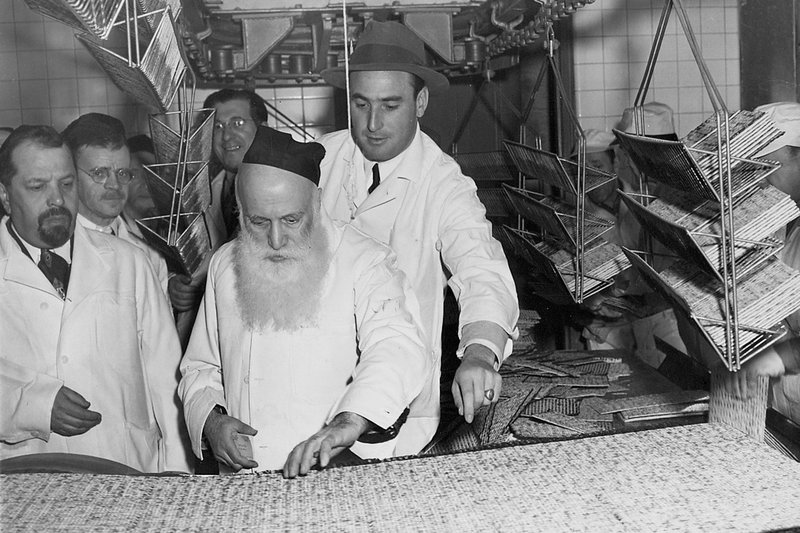 Cake Filled with Cabbage: buttery, sweet and savory.
Cake Filled with Cabbage: buttery, sweet and savory.
In the early 20th century, a group Jewish people believed that the less meat you ate, the closer you would be to god. By refraining from eating meat and fish, one could avoid the necessity of slaughtering living beings. This idea was epitomized in The Vilna Vegetarian Cookbook (originally published as Vegtarish-Dietischer Kokhnukh: 400 Shpeizn Gemakht Oysshlislekh fun Grsin, or Vegetarian-Dietetic Cookbook: 400 Recipes Made Exclusively from Vegetables), a kosher cookbook published in 1938. Originally printed in Lithuania, it was recently re-released and translated into English. For a special event promoting the book’s release, I was asked to prepare a recipe; typically for me, I picked the weirdest recipe I could find: cabbage cake.
The History
Because the laws of kosher dictate the separation of meat and dairy, there are many vegetarian (and vegan) recipes among Jewish cultures. In New York City, as well as in other Jewish centers, dairy restaurants and appetizing stores flourished at the turn of the century, alongside their meat counterparts, delicatessens. Additionally, vegetarian meals were more affordable; so often, a Jewish family on a budget–or in a situation where they had little access to meat–would turn to vegetarian recipes like the ones offered in The Vilna Vegetarian Cookbook.
The book’s author, Fania Lewando, ran her own vegetarian restaurant and kosher cooking school in Vilna, Lithuania. In her introduction, she enthused on the virtues of a vegetarian life, spoke on the health giving properties of plants, and gave a a brief history of vegetarianism as “a Jewish movement.”
And she offered great practical advice, like “Throw nothing out, everything can be made into food. For example, don’t throw out the water in which you have cooked mushrooms or green peas; it can be used for various soups. Don’t throw out the vegetables used to make a vegetable broth. You can make various foods from them, as shown in this cookbook.”
Many of her recipes are simple and practical; others are fashionable, and sometimes even outrageous. In the pages of her cookbook, you can find Pickle Soup, a stew of root vegetables, peas and pickle brine; Buckwheat Kasha Cutlets, a homemade meat substitute similar to the foods Kellogg served at his vegetarian Sanitarium; Stuffed Imitation Kishke, the vegetarian version of a traditional sausage of stuffed beef intestine; and even a recipe for Kvass, a fermented beverage made from rye bread.
Cabbage Cake — or “Cake Filled with Cabbage” — intrigued me because who fills a cake with cabbage? But like the many bizarre recipes I am tempted to try, I saw potential. It layered a buttery, savory yeast dough with a slow cooked mix of butter, cabbage and onions.
 Assembling the cake.
Assembling the cake.
The Recipe
Cake Filled with Cabbage
Adapted from the Vilna Vegetarian Cookbook, By Fania Lewanda, 1938
Translated from the original Yiddish by Eve Jochnowitz
4 cups white flour
1 packet yeast
1/2 cup milk, warm
1.5 cups (three sticks) unsalted butter
5 egg yolks
3 eggs
2 tablespoons sugar
Salt
1 Head of cabbage, shredded (about 2 pounds)
1 cup chopped onions
Salt
- In a large bowl, sprinkle cabbage with 1 tablespoon of salt. Set aside.
- Make the dough: Pour 4 cups white flour into a bowl. Dissolve yeast in milk, stirring gently with a fork. Add to flour. Add 5 egg yolks, 2 eggs, sugar, a pinch of salt and 1/2 cup melted butter, stir until combined. On a well-floured board, knead for three minutes. Return to bowl, cover with a towel and set aside. Let dough rise one hour.
- Wrap cabbage in a towel and squeeze–or press through a strainer–to remove water. Over medium-heat heat, melt 1 cup butter. Add cabbage and onions, and cook, stirring occasionally, until brown.
- On a well-floured board, divide dough in half, and roll into two sheets, each about 1/4 inch thick.
- Grease a baking sheet. Lay one sheet of dough on the baking sheet, cover with cooked cabbage mixture, and then cover with the second sheet of dough. Pierce it all over with a fork and allow it to rise 30 minutes. Preheat over to 350 degrees. Brush top of dough with a beaten egg, and bake 45 to 50 minutes, until the top is toasty brown and bubbly.
 Out of the oven!
Out of the oven!
The Results
Since I made this cake for an event, the results were fed to about 100 people. I was worried the cake might be too weird. But in the end, it’s all about the experience; which is why I pick the recipe that sounds the most interesting, not the one that sounds the most delicious.
But thankfully, Cabbage Cake was both interesting and delicious. The yeasty dough paired perfectly with the buttery cabbage, that savory filling contrasting with the slightly sweet crust. The crust was crisp, and the filling melt-in-your mouth. It was an all around hit, and a dish I would make again as a vegetarian side or even a main course.
If you live in the new York City area and you’d like to learn more about the history of Jewish cuisine, I’m giving a special program at the Lower East Side Tenement Museum on May 18th. It will feature a tour focusing on the diversity of Jewish food, as well as a cooking class! Sign up here!


